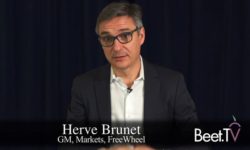MIAMI – As the advertising industry seeks to unify premium video and traditional television, there is a need for speed and there are speed bumps. Given these dynamics, it’s fair to ask whether consolidation on the adtech side will drive the most change or will it be the increasing demands of advertisers for greater outcomes from their video and TV investments, according to Ashley J. Swartz, who moderated one of several panels at the recent Beet Retreat Miami 2017.
The CEO of linear TV and video yield optimization provider Furious Corp. probed the panelists for their thoughts on how bring together all the players that are required to advance the TV and video ecosystem in a way that benefits brands and consumers.
What follows are some of the more salient dialogue and exchanges from Brian Katz, VP of Advanced TV Insights & Strategy at Eyeview; Mark Gall, Chief Revenue Officer at Alphonso; Tore Tellefsen, VP of TV Solutions at dataxu; and Neil Smith, SVP, Markets at FreeWheel.
On the need for speed of data delivery:
Alphonso has an always-on, real-time index of every program and ad airing across over 200 broadcast and cable networks and major OTT services, so buyers can see the number of units plus reach and frequency for their clients and competitors. “You don’t have to wait six months any more or six weeks anymore. You can get that in real time. And that’s something that TV buyers have never had before. In real time. Speed is key,” said Gall.
On the need for speed in personalized creative:
“We’ve made the process very simple for our clients,” said Katz. “We don’t show every single creative to the creative team. We storyboard the process with their ads, we show where we’re going to come into play with various creative and then we activate it.”
Asked by Swartz whether all clients are so trusting, Katz explained, “It’s not all marketers, all brands. And that is the challenge for us to educate and to develop that trust with clients and marketers.”
How does one get people who are very comfortable with traditional TV media to embrace more data-driven decisioning? “The short answer is patience and repetition,” said Tellefsen. “What we try to focus on or try to push and emphasize is get as many people to the table as possible and not focus on sort of specific point solutions or specific capabilities but spending a lot of time talking about the art of the possible. Here’s how other people are employing it.”
Said Smith: “We want to bridge that gap between marketers and consumers. We consciously work across the value chain. We do tons of education and advocacy to brands, agencies, agency trading desks, buy-side technology companies, data companies.”
Asked how much of an influence fear has on peoples’ ability to change, Katz responded, “I haven’t seen any fear out there. I think it’s just a lack of education and the unknown that people fear and maybe the way certain businesses are set up sort of the fear of losing certain budgets or influence over decision making.”
Will vertical tech stacks become horizontal ones in the desire for a more unified TV and video ecosystem?
“Right now in the TV to mobile targeting business or the attribution business it’s still probably in the innovation or early adoption phase of our industry and we have to really work together,” said Gall.
So is it the gradual consolidation of the largest media companies that will bring the tipping point to the industry or the power of advertisers to demand faster change? “What is going to have a greater influence on us thriving and not just surviving for scraps as an industry through the current storm that we’re in,” asked Swartz.
Katz: “I think it’s a combination of consolidation and collaboration.”
Tellefsen, speaking about the impact of companies like Amazon and Netflix, called those digital upstarts “tremendous competitors and tremendous forces in the industry. And it’s forcing everyone in this room to rethink how they do business, who they do business with and how they’re going to remain relevant to brands and advertisers for the future.”
Smith: “I think it’s the ability to put all the pieces together to deliver that that’s been the challenge that we’re working through. I think that gets a lot easier when you have consolidation and you have a critical mass to bring those solutions to market in ways that they can connect together and actually work.”
And on the need for greater collaboration: “I think the marketers are demanding it,” said Gall. “Within three years if you don’t deliver it, you’re dead. So I really think they’re pushing the piece.”
This video was produced at the Beet Retreat Miami, 2017 presented by Videology along with Alphonso and 605. For more videos from the event, please visit this page.



























